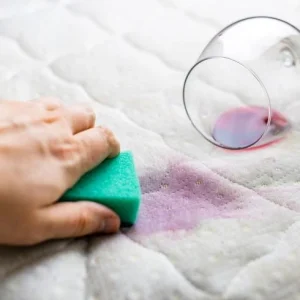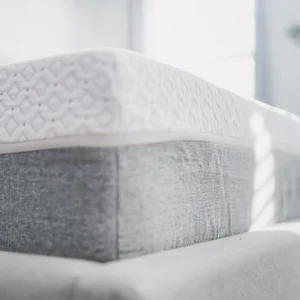Mattress Cleaning
The average person spends 26 years (or one-third) of their life sleeping and another seven years trying to fall asleep. Factor in all the Netflix, reading or just hanging out, and it’s safe to say that you spend more time in bed than in any other area of your house. Surprisingly, this is the area most people aren’t cleaning nearly enough. It’s also important to remember that mattresses are a pricey necessity. Mattress Cleaning is essential to ensure it lasts for the expected seven to ten years.
This guide will explain exactly how to clean your mattress properly and how often you should do it. Plus, we’ll debunk the common mattress-cleaning myths that could actually be making you sick.
Why You Need to Clean Your Mattress More
Wondering why it’s so important to keep your bed as clean as can be?We shed an average 12 million skin cells and sweat out one pint every single night while we sleep. This goes directly into our bedding—and if we aren’t careful, our mattress.
All this built up bacteria creates the perfect atmosphere for dust mites. You know dust mites? The tiny microscopic relatives of the spider that live on mattresses and bedding for up to 90 days.
Warning: Googling will lead to instant body shivers and the undeniable desire to deep clean your bedroom.
Mattress Cleaning by Vacuuming your Mattress
Remember those dust mites that we talked about earlier? Well, dead skin cells are their idea of a five-star buffet and you are shedding 12 million of them every single night.
Once you strip the bed, always vacuum your mattress with an upholstery attachment followed by a crevice tool if you have a plush mattress top with any sort of quilting pattern where dirt and debris tends to hangout.
And yes, you need to vacuum your mattress even when you can’t see anything!
Dust mites measure only about one-quarter to one-third of a millimeter and are impossible to see without a microscope. The skin cells they love to feast on are even smaller.
Trust us, you need to vacuum weekly.
Strip Your Bed Linens for Mattress Cleaning
Once a week strip your bed of all linens including sheets, duvet cover, shams and throw pillow covers. Choose a day of the week and make it the official “bed cleaning day” so that you don’t put it off or forget. Wash your bedding separately from other clothing loads and choose a warm, heavy cycle. Only use the highest heat wash cycle if there are stains as this can cause your sheets to shrink (we’re looking at you cotton). When it comes to bedding, skip the fabric softener. It causes your bed linens to lack absorbency and breathability overtime, both of which can be harmful for your mattress.
Should I Change My Sheets More Often?
If you prefer to sleep in the buff, have a pet that shares the covers with you, have recently been sick or sweat often while sleeping, you’ll want to bump up your sheet washing frequency to at least twice a week. Also if you are experiencing more breakouts than usual, your pillow case may be to blame, try switching out your pillowcase for a fresh one every third night.
Spot Clean Stains in Mattress Cleaning


Now that your bedding is in the wash and your mattress is vacuumed, it’s time to do a visual check. If you have any stains on the mattress, you must resist the temptation to pull out the shampooer. While it may feel like the obvious next step to get that “clean” mattress, any moisture that gets stuck in your mattress can lead to bacteria (even mold) that can make you sick—not to mention, make your bank account hurt because you’ll likely be in the market for a new mattress. An effective way to remove sweat, blood or urine stains from your mattress, is to simply spot clean using an enzyme cleaner sparingly. Blot the cleaner away first with a damp cloth before switching to a dry one.
Time to Deodorize
If you haven’t discovered the unlimited possibilities of baking soda, your home is about to be enlightened. Baking soda is one of the most versatile, effective, natural cleaning products you can get your hands on and that remains true when it comes to tackling your mattress.
Depending on the size, the amount of baking soda needed to clean your mattress will vary; however, you’ll want to use a sifter to help evenly spread baking soda on the surface of your bed.
While you let the baking soda sit for 30 minutes (it doesn’t hurt to leave it longer!), it is going to absorb the inevitable odor and any moisture sitting on the mattress’ surface. When you’re ready, vacuum your mattress once again, but be mindful of what vacuum you use.
Overtime, the fine baking soda powder can damage your vacuum’s motor. If possible, use a shop vacuum that is better equipped to handle fine powders.
Don’t Forget the Rest of the Bed
While you’re waiting for the baking soda to do its magic, you can work on cleaning your actual bed—the headboard, frame and everything else you’ve ignored since purchasing it.
Before getting started on your headboard, pull out your mattress at least a foot so any dust that falls during the process is not falling directly onto your mattress. Whether you have a wood or a fabric headboard, start by vacuuming as much as you can.
For any hard surfaces, use an appropriate cleaner (antibacterial when possible) thoroughly wipe away any leftover dust and germs.
This is also a great time to look under the bed and tackle any trust that’s been lingering.
Rotate or Flip the Mattress
This next step is dependent on the type of mattress you have. While flipping some mattresses is the best way to extend their comfort lifespan, others are designed differently and cannot be flipped. However, generally most mattresses can be rotated.
This is not a weekly task, but should be done once a season or four times a year. If you’re having a hard time remembering to do this, you can use safety pins to attach a small paper sign that reads “January” right side up and “April” upside down. On the other side of the mattress repeat with “July” right side up and “October” upside down.
When one of the months rolls around, flip the mattress so that month reads upright.
Let Your Mattress Breathe


Even if you have two or more sets of sheets, do not remake your bed right after stripping it. When our bed is made, the mattress is unable to breathe and dry from the moisture and odor that can naturally build up.
Weather dependent, open your bedroom windows and leave your mattress fully bare for the rest of the day.
The next time you go on vacation, try to leave your mattress bare. Even with the window closed, this can help ensure odor and moisture is not trapped while you’re gone. =
Related: The Best Canadian Mattress Brands, Ranked by Budget
Your Pillow is Probably the Culprit
Have you ever experienced a stale smell in your bedroom? Well, it could be because of your pillow. Many will be surprised to learn that the lifespan of a pillow is one to two years. Do you even remember when you bought your pillow?
If your pillow smells bad, has noticeable lumps, is flat enough to fold, requires constant re-fluffing or causes neck and shoulder pain, it’s probably time to invest in a new one.
Also pillows actually can, and should, be washed every three to four months.
You’ll want to double check the labels and washing instructions of your particular brand of pillows, but it is recommended to dry any pillow on a low setting for an extended period of time to avoid bacteria and mold from fostering inside.
How to Arrange Pillows on Your Bed and Sofa, According to a Decor Expert
Protect and Prevent
The best way to prevent your mattress from becoming infested with dust mites, bacteria or mold is to be preventative. Using protectors ensure that moisturize doesn’t leak into and damage your mattress and pillows. Both mattress and pillow protectors stay underneath your sheets and pillowcases even during weekly bedding washes.
We recommend washing protectors every two months, but ensuring they are completely dry before putting them back on.
Mattress protectors mean that any stains that would otherwise be on the mattress are stopped in their tracks. Since mattress and pillow protectors can be washed, bleached and if needed replaced, this is a small price to pay to protect your mattress investment.
If you want to prevent other bedding such as spare comforters or duvets from becoming a breeding ground for mildew, avoid storing them in plastic bags with trap moisture. Instead, store in breathable cotton or linen bags to keep them free of dust and disgust.
Maintaining Your Clean Mattress
The best way to clean your mattress is by doing it frequently. Once into a routine, these recommendations for properly cleaning your mattress will become second nature. Here’s a quick study you can save for reference:
Once every three days: Wash pillow cases if experiencing acne or entire sheets if you’re sweating, sleep nude, have been sick or sleep with a pet.
Once a week: Wash all bedding, vacuum mattress, deodorize and let it breathe unmade.

